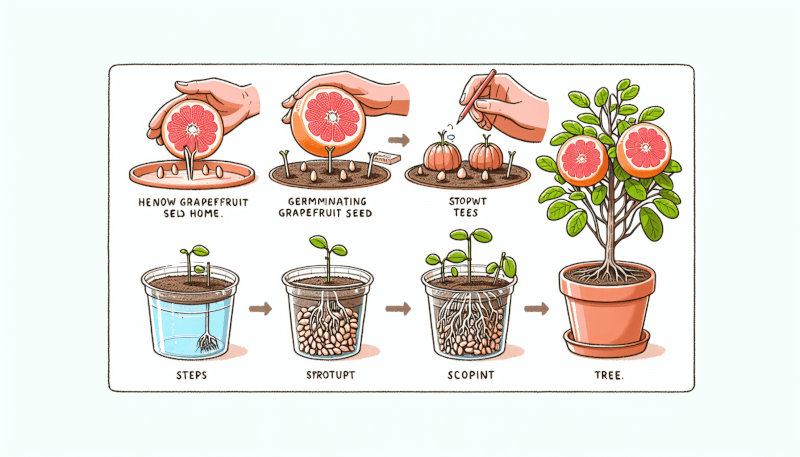👋 Click the mic button to talk to Alfred, the Todd's Seeds Gardening/Sprouting Expert – Feel free to ask him anything!
Ask Virtual Todd Anything - Click the Mic
Have you ever wondered how to grow your own grapefruit tree from scratch? Look no further! In this article, we’ll show you a simple and effective method to germinate grapefruit seeds right at home. You’ll learn everything you need to know about the germination process, from selecting the perfect seeds to providing them with the ideal conditions for sprouting. Get ready to embark on a joyful journey of nurturing and watching your very own grapefruit tree come to life!

Choosing Grapefruit Seeds
When it comes to choosing grapefruit seeds, there are a few factors to consider. First, make sure you select seeds from a healthy and mature grapefruit. This will increase the chances of successful germination and yield strong and vigorous plants. Look for grapefruits that are ripe and juicy, as this indicates that the seeds inside are fully developed.
It’s also important to choose grapefruit seeds from a variety that suits your climate and growing conditions. There are different types of grapefruits with varying levels of cold tolerance, so select seeds from a variety that will thrive in your region. This will ensure that your grapefruit trees will be able to withstand the climate and produce abundant fruit.
Seed Selection
When selecting grapefruit seeds, it’s best to choose seeds that are plump and firm. Avoid seeds that are shriveled or damaged, as these may not be viable and may not germinate successfully. Additionally, try to choose seeds that are relatively fresh. Older seeds may have a lower germination rate and take longer to sprout.
If possible, it’s a good idea to obtain seeds from a reputable source, such as a nursery or garden center. This way, you can be confident that the seeds are of high quality and have been properly stored. However, if you have access to fresh grapefruits, you can easily extract the seeds yourself.
Seed Viability
Determining the viability of grapefruit seeds is crucial before germinating them. There are a few methods you can use to check the viability of the seeds. One simple test is the float test. Fill a container with water and place the seeds in it. If the seeds sink to the bottom, they are likely viable. However, if they float, they may not be viable and may not germinate successfully.
Another method is the squeeze test. Gently apply pressure to the seeds with your fingers. If they feel firm and don’t collapse easily, they are likely viable. On the other hand, if they feel soft and squishy, they may not be viable and may not germinate.
If you’re unsure about the viability of your grapefruit seeds, you can also try germinating a few of them to see if they sprout. This will give you a clearer indication of their viability and help you decide whether or not to proceed with germination.
Preparing the Seeds
Before you can germinate grapefruit seeds, it’s important to properly prepare them. This involves extracting the seeds from the grapefruit, cleaning them, and drying them to remove any moisture.
Seed Extraction
To extract the seeds from the grapefruit, carefully cut the fruit in half and remove the flesh. Rinse the seeds under cool water to remove any remaining pulp. It’s important to handle the seeds gently to avoid damaging them.
Seed Cleaning and Drying
After the seeds have been extracted, they should be cleaned to remove any remaining debris or pulp. You can do this by gently rubbing the seeds between your fingers or using a soft cloth. Be careful not to rub too hard, as this can damage the seeds.
Once the seeds are clean, it’s important to dry them thoroughly. Excess moisture can inhibit germination and lead to mold or fungal growth. Place the seeds on a paper towel or a clean, dry surface and allow them to air dry for a few days. Make sure they are completely dry before proceeding with germination.
Creating a Suitable Growing Environment
Creating the right growing environment is essential for successful germination and the healthy growth of grapefruit seeds. This involves providing the seeds with a suitable germination container and a proper growing medium.
Germination Container
For germinating grapefruit seeds, it’s best to use a container with good drainage to prevent waterlogging. You can use seed trays, small pots, or even recycled containers as long as they have drainage holes. Ensure that the container is clean and sterilized to minimize the risk of disease and pests.

Growing Medium
The growing medium you choose plays a crucial role in supporting the germination and growth of grapefruit seeds. A well-draining and nutrient-rich medium is ideal for these seeds. You can create a suitable growing medium by combining equal parts of peat moss or coconut coir, perlite or vermiculite, and compost or organic matter.
Ensure that the growing medium is moist before planting the seeds, but not overly wet. Squeeze a handful of the medium and if a few drops of water come out, it’s at the right moisture level.
Germinating Grapefruit Seeds
Germinating grapefruit seeds requires specific techniques to break their dormancy period and encourage sprouting. This involves scarification, stratification, and planting the seeds correctly.
Seed Scarification
Grapefruit seeds have a tough outer covering that can hinder germination. Scarification is the process of breaking or weakening this outer shell to allow moisture and oxygen to penetrate the seed. To scarify grapefruit seeds, gently file or scratch the outer shell using sandpaper or a nail file. This will create tiny openings and help the seeds absorb water more easily.
Seed Stratification
Stratification is another technique used to overcome the dormancy of grapefruit seeds. This process simulates the conditions the seeds would naturally experience in their native environment, where they go through a cold and moist period before sprouting. To stratify grapefruit seeds, place them in a sealed plastic bag with a damp paper towel and refrigerate them for 4-6 weeks. This will break their dormancy and prepare them for germination.

Seed Planting
Once scarification and stratification have been completed, it’s time to plant the grapefruit seeds. Make a small hole in the growing medium, about 1/2 to 1 inch deep. Place the seed in the hole and cover it lightly with the growing medium. Gently pat down the soil to ensure good contact with the seed.
Caring for Germinating Seeds
After planting the grapefruit seeds, proper care and maintenance are crucial to support their growth and development.
Watering
During the germination stage, it’s important to keep the growing medium consistently moist but not waterlogged. Water the seeds gently using a spray bottle or a watering can with a fine rose attachment. Avoid overwatering, as this can lead to root rot and other fungal diseases. Monitor the moisture level regularly and adjust watering accordingly.
Light Exposure
Grapefruit seeds require adequate light to germinate and grow. Place the germination container in a bright location with indirect sunlight. If you don’t have access to natural light, you can use grow lights or fluorescent tubes to provide the necessary light for the seeds. Keep the lights on for 12-16 hours a day and ensure they are positioned at an appropriate distance from the seeds to avoid burning or overheating.

Temperature Control
Maintaining a consistent temperature is essential for the successful germination of grapefruit seeds. The optimal temperature range for germination is between 70-85°F (21-29°C). Avoid exposing the seeds to extreme temperature fluctuations or prolonged periods of cold or heat, as this can negatively affect their growth. Use a thermometer to monitor the temperature and adjust accordingly using heating mats or fans if necessary.
Transplanting Sprouted Seedlings
Once the grapefruit seeds have sprouted and developed into seedlings, it’s time to transplant them into larger containers to allow for further growth.
Potting Up
Transplant the sprouted seedlings into individual pots that are at least 4-6 inches in diameter. Fill the pots with a well-draining potting mix, making sure not to bury the seedlings too deep. Gently firm the soil around the seedlings to provide support. Place the pots in a location with bright, indirect sunlight and continue to provide proper care as outlined earlier.
Hardening Off
Before permanently planting the grapefruit seedlings outdoors, it’s important to harden them off. Hardening off gradually exposes the seedlings to outdoor conditions, helping them adjust to the differences in temperature, light, and wind. Start by placing the seedlings outside for a few hours each day, gradually increasing the time over the course of a week. Be sure to protect the seedlings from strong winds and direct sunlight during this period.

Nurturing Young Grapefruit Plants
As your grapefruit plants continue to grow, there are specific care practices that will ensure their health and productivity.
Watering and Fertilizing
Regular watering is essential for young grapefruit plants. Keep the soil consistently moist but not waterlogged. As the plants grow, gradually increase the amount of water provided to encourage deep root growth. Additionally, fertilize the plants every 4-6 weeks with a balanced citrus fertilizer. Follow the manufacturer’s instructions for proper application rates. Consistent watering and fertilizing will provide the plants with the necessary nutrients to thrive.
Pruning
Pruning young grapefruit plants is important for shaping and encouraging healthy growth. Remove any dead or damaged branches, as well as any branches that are crossing or rubbing against each other. This will improve airflow and reduce the likelihood of disease. Additionally, prune the plants to maintain a desired shape and remove any suckers or water sprouts that may emerge from the base of the plant.
Pest and Disease Control
Keep a close eye on your young grapefruit plants for any signs of pests or diseases. Common pests that can affect grapefruit trees include aphids, scale insects, and citrus leaf miners. Use organic or chemical controls as necessary to manage these pests. Additionally, be on the lookout for diseases such as citrus canker or citrus greening. Follow proper cultural practices such as regular pruning, proper watering, and regular fertilizer application to minimize the risk of disease.
Growing Grapefruit Trees
As your grapefruit plants mature into trees, they require additional care and attention to ensure optimum growth and fruit production.
Transplanting to a Sunny Spot
When your grapefruit trees have outgrown their pots, it’s time to transplant them into the ground. Choose a location that receives full sun, as grapefruit trees require at least 6-8 hours of direct sunlight daily to produce quality fruit. Ensure that the soil is well-draining and amend it with organic matter if necessary. Dig a hole that is slightly wider and deeper than the tree’s root ball. Gently place the tree in the hole, making sure it is at the same depth as it was previously. Backfill the hole with soil, firm it gently, and water thoroughly.
Proper Watering and Fertilizing
Established grapefruit trees require regular watering to support their growth and fruit production. Water deeply but infrequently, ensuring that the soil is evenly moist. Monitor the soil moisture regularly and adjust watering based on rainfall and temperature. Additionally, continue to fertilize the trees every 4-6 weeks during the growing season using a citrus-specific fertilizer. Follow the manufacturer’s instructions for proper application rates.
Supporting the Tree
As your grapefruit tree grows, it may require additional support to ensure proper growth and prevent damage from strong winds or heavy fruit. Install a sturdy stake or trellis next to the tree and secure it with ties or wire. This will help support the trunk and branches, reducing the risk of breakage. Regularly check the ties or wire to ensure they are not cutting into the tree’s bark and make adjustments as necessary.
Harvesting Grapefruit
The ultimate reward of growing grapefruit trees is the delicious fruit they produce. However, it’s important to know when and how to harvest the fruit to ensure optimal flavor and quality.
Determining Maturity
Grapefruits are ready to harvest when they have reached their full size and the skin has turned a bright and vibrant color. Each variety of grapefruit has its own specific maturity indicators, so consult the variety’s specific guidelines for more accurate information. Additionally, the fruit should be firm to the touch and have a slight give when squeezed. It’s important to avoid harvesting the fruit too early, as this can result in a tart and underdeveloped flavor.
Harvesting Techniques
To harvest grapefruit, carefully cut or twist the fruit from the tree using clean and sharp gardening shears or secateurs. Avoid pulling or tugging on the fruit, as this can damage the tree or cause the fruit to drop prematurely. It’s best to harvest the fruit in the morning when the temperatures are cooler. After harvesting, gently wipe off any excess dirt or debris from the fruit and store them in a cool, dry place.
Conclusion
Growing grapefruit from seeds can be a rewarding and fulfilling experience. By carefully selecting viable seeds, preparing them properly, and providing the right growing conditions, you can successfully germinate and grow your own grapefruit trees. With proper care and maintenance, your trees will produce bountiful harvests of delicious and juicy grapefruits. Enjoy the process of nurturing your grapefruit plants and reap the benefits of your labor by enjoying the sweet rewards of homegrown citrus!